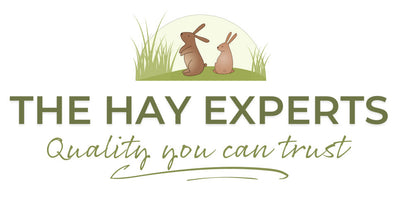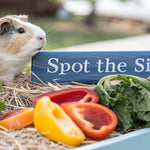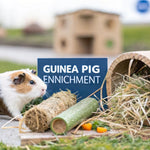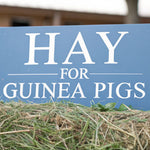Your Guide to Guinea Pig Enrichment
- by The Hay Experts
-

When we talk about guinea pig enrichment, we’re not just talking about giving them a few toys to bat around. It’s about creating a whole world for them, a space that lets them act on their natural instincts. This is absolutely essential for their mental and physical health, helping to head off boredom and stress for a much happier, healthier piggy.
Why Guinea Pig Enrichment Is So Important
Imagine being stuck in the same room day in, day out, with nothing new to see, do, or explore. You'd get bored and listless pretty quickly, right? Well, that's what life can feel like for a guinea pig without the right kind of stimulation. That's why providing enrichment isn't just a nice "extra"—it's essential and a core part of being a responsible owner. It is vital for your pet's welfare.
Giving them chances to forage, hide, chew, and socialise is all about mimicking what they’d do in the wild. A cavy with things to do is far less likely to develop health problems linked to being inactive or stressed out. This isn't just our opinion; it’s a view backed by animal welfare experts who consistently highlight just how vital an engaging environment is to help your pet thrive.
This image really drives home how enrichment supports a guinea pig's most basic needs.

The main thing to remember is that enrichment is a complete package. It boosts their physical health, keeps their little minds whirring, and encourages all those brilliant natural behaviours. Each part works together to build the foundation for a truly happy life.
The 5 Pillars of a Fulfilling Cavy Life
To really help our little friends thrive, we can break enrichment down into five key areas. Think of these as the pillars holding up a happy cavy existence. Each one targets a different part of their well-being, making sure everything is balanced.
We've put together a quick table to summarise these five pillars. It’s a great way to see, at a glance, how each type of enrichment plays a unique and important role.
The 5 Pillars of Guinea Pig Enrichment
| Enrichment Type | Core Purpose | Example Activities |
|---|---|---|
| Social | To satisfy their deep-seated need for companionship as herd animals. | Housing them in bonded pairs or groups; supervised interaction. |
| Physical | To encourage movement, prevent obesity, and keep muscles strong. | A spacious enclosure; safe, supervised floor time; tunnels to run through. |
| Sensory | To stimulate their senses of touch, smell, and sight. | Different textures (e.g., fleece, hay, cardboard); safe herbs; changing cage layout. |
| Nutritional | To make eating an active and engaging challenge, not just a passive meal. | Hiding food in hay; using puzzle feeders; scattering forage. |
| Cognitive | To challenge their minds, prevent boredom, and build problem-solving skills. | Foraging toys; learning simple tricks; introducing new safe objects to investigate. |
By focusing on all five, you’re not just meeting their basic needs—you're helping them live their best life.
Official UK animal welfare guidance couldn't be clearer on these points. It actually states that guinea pigs must be housed socially to support their mental health. What's more, providing unlimited hay is considered essential enrichment in its own right. It encourages natural grazing and foraging, which can stop compulsive habits like over-grooming or hair-chewing from developing. If you're keen to learn more, you can explore the full welfare standards and the science behind them.
Building a Stimulating Home Environment

Your guinea pig’s enclosure is so much more than just a cage; it’s their entire world. By putting a little thought into how you arrange their home, you can turn it from a simple box into an exciting, multi-zone habitat that encourages all their natural instincts and makes them feel completely safe.
As prey animals, a guinea pig’s number one priority is feeling secure. If they feel exposed or vulnerable, they can easily become stressed and withdrawn. Giving them plenty of places to hide is the absolute foundation of a great setup, tapping directly into their powerful need for cover.
Think of their habitat as their own personal sanctuary. The goal is to create distinct areas for different activities—a quiet corner for napping, a bustling "kitchen" for mealtimes, and an open space for a bit of zoomie fun. This separation gets them moving and exploring, making their daily life far more interesting.
Creating Safe Havens and Zones
The secret to a fantastic setup is using a variety of items to break up the space. This isn't just about making it look pretty; it's about building a functional environment that meets their behavioural needs. By placing things strategically, you create little pathways and destinations that get your piggies moving around.
Essential bits and pieces for creating these safe zones include:
- Tunnels: These are perfect for encouraging dashing and running. Our range of Tunnels is brilliant because they mimic the burrows they’d use in the wild and help your pet feel secure as they move. Pop one between their food bowl and a hideout, and you've created a safe "commute"!
- Hideouts: Having a mix of hideouts, from wooden cottages to soft fleece beds, gives them variety and choice. Make sure you have at least one hidey per guinea pig to prevent any squabbles and give everyone their own private space.
- Fleece Forests: These hanging strips of fabric create a curtain-like barrier that guinea pigs absolutely love to walk through. A cosy fleece forest is an excellent product for placing in more open areas, providing cover that helps your piggy feel safe without completely blocking off the space.
Adding Sensory Stimulation
Beyond what they can see, you can enrich their home through touch. The flooring of their enclosure provides a constant sensory experience for their sensitive little feet. Using different textures in different areas adds another fantastic layer of interest.
For example, you could have soft fleece liners in their sleeping area for maximum comfort, then a shallow tray of paper-based bedding or soft hay in their "kitchen" zone. This textural variety encourages them to explore all the different parts of their home and really engages their senses.
By building a habitat with a bit of intention, you're directly contributing to their daily welfare and happiness. It makes all the difference.
Turning Mealtime into a Foraging Adventure

Mealtimes are, without a doubt, one of the most exciting parts of a guinea pig's day. You know the sound – those happy wheeks and excited chirps are unmistakable! But just plopping their food in a standard bowl, while easy, misses a huge opportunity to enrich their lives.
By turning feeding time into a bit of a challenge, you're tapping directly into their powerful, natural instinct to forage, which is essential for their well-being.
In the wild, guinea pigs (or cavies, as they're properly known) would spend a huge chunk of their day searching high and low for food. Bringing a little bit of that experience into their home is a brilliant way to beat boredom, get them moving, and give their clever little brains a workout. It doesn't need a massive effort, just a touch of creativity.
Making Hay the Star of the Show
We all know that hay makes up around 80% of their diet, so it's the perfect place to start with enrichment. Making them 'work' for their hay isn't just fun for them; it actually encourages them to eat more of this vital fibre, which is fantastic for their teeth and tummies.
Instead of just piling hay in a corner, why not try a few of these simple ideas?
- Cardboard Creations: Stuff empty toilet paper rolls or untreated cardboard boxes with their favourite hay. They will have a brilliant time nibbling, pushing, and tearing at the cardboard to get to the goodies inside.
- Hay Racks and Bags: Using different types of hay feeders means they have to pull and tug at the strands to get them out. This simple action is very similar to how they'd graze naturally and can keep them happily occupied for ages.
By making food a little harder to get, you’re providing a puzzle that rewards them with every bite. This active participation turns a simple meal into a positive experience that satisfies both their hunger and their need for mental stimulation.
Puzzles, Treats, and Veggie Challenges
It's not just about hay! You can make their daily pellets and fresh veg part of the foraging fun, too. This is where you can really get their curiosity going and put their problem-solving skills to the test.
Hiding a few healthy treats or their daily pellets inside a puzzle feeder or a treat ball is a great challenge. They'll have to nudge, roll, and figure out how to manipulate the toy to get the food out. It's wonderful to watch their personalities shine through as they work out the puzzle.
Another fantastic idea is to hang fresh, leafy greens like parsley or romaine lettuce from the top of their enclosure using a pig-safe clip. This encourages them to stretch up and stand on their back legs, which is great for their muscles and a really fun way for them to eat. You can also spark their amazing sense of smell by scattering small bits of fragrant herbs. Our hand-picked selection of natural guinea pig forage offers a wonderful variety of safe, dried flowers and herbs that are perfect for this, helping you to easily add sensory variety to their day.
These little changes do more than just stop your piggy from getting bored. They help build an even stronger bond between you, as you become the one who brings these exciting daily adventures into their life.
Exploring New Sights and Smells Outside the Cage

A guinea pig’s cage is their castle, their safe space. But the world beyond those bars offers a thrilling new dimension for physical and sensory fun. Supervised ‘floor time’ is a fantastic way to broaden their horizons, letting them really stretch their legs, build up their muscles, and indulge that famous piggy curiosity in a controlled way.
Think of floor time as a mini-adventure for your furry friends. It's a much-needed break from their usual routine that helps keep them at a healthy weight and gives their busy little brains a workout. To make this time count, the secret is to create a space that’s both completely safe and genuinely exciting, encouraging them to explore with confidence.
Creating a Safe Play Zone
Before you let your piggies roam, you absolutely must create a guinea-pig-proof area. This means tucking away all electrical wires, scouring the floor for any small objects they could nibble or swallow, and making sure no other household pets can wander in. A portable playpen is an excellent bit of kit for this, creating a secure boundary you can pop up just about anywhere.
Once the space is secure, you can start adding the fun stuff. Just remember, an empty, open floor can feel pretty intimidating for a small prey animal. You’ll need to add points of interest and plenty of cover to make them feel comfortable enough to start exploring.
Here’s how to build an engaging play area:
- Vary the Textures: Lay down different surfaces for them to experience. A soft fleece blanket in one corner, a grass mat in another, and even a tray of their regular bedding can provide a wealth of new feelings for their sensitive little feet.
- Introduce Safe Scents: A guinea pig's sense of smell is incredibly powerful. Try tucking a fresh, piggy-safe sprig of mint or parsley into a corner to spark their interest and get them investigating.
- Build an Adventure Playground: Use untreated cardboard boxes to build simple mazes or tunnels. This isn't just great physical exercise; it's also a mental puzzle as they navigate the structures. Adding some of their favourite floor-safe toys will encourage play and help you get the best out of this time with your pet.
The goal of floor time isn't just to let them run around, but to provide a multi-sensory experience. By introducing new sights, smells, and textures, you are actively enriching their world and building their confidence.
By making floor time a regular and exciting part of their week, you're doing so much more than just providing exercise. You’re strengthening your bond, fighting off boredom, and giving them a vital outlet for their natural instincts, ensuring your furry friends are as happy and healthy as they can possibly be.
Safe and Simple DIY Enrichment You Can Make Today
Giving your guinea pigs fantastic enrichment doesn’t mean you have to splash the cash. In fact, some of the most engaging and exciting experiences come from simple household bits and bobs you probably already have lying around. The real trick is knowing what’s safe to use and how to turn it into something that sparks your piggy’s natural instincts.
DIY enrichment is all about getting creative while keeping safety front and centre. A plain cardboard box isn't just rubbish; it’s the beginning of a brand-new fort. That empty toilet paper tube? It’s the perfect container for a foraging challenge. When you start to see these everyday objects through your guinea pig's eyes, you open up a whole world of fun that directly boosts their well-being.
Safe Materials First
Before you start building your piggy palace, it’s vital to get to grips with which materials are safe. Guinea pigs will have a good chew on almost anything, so whatever you give them must be non-toxic and not pose a choking hazard.
Your golden rule should always be: if in doubt, leave it out.
- Untreated Cardboard: The inner tubes from toilet paper or kitchen rolls, and plain cardboard boxes (with all tape and labels stripped off) are absolute gold. They’re perfect for chewing, hiding in, and gleefully destroying.
- Natural Twine: Sisal, hemp, or other natural, untreated twines are brilliant for hanging veggies or tying things together. Just be sure to avoid nylon or synthetic strings, as they can cause serious harm if ingested.
- Fleece and Old Towels: Scraps of fleece or old, clean towels (check for and remove any loose threads) can be turned into cosy beds, hideouts, or even a "fleece forest" for them to wander through.
- Paper Bags: Brown paper bags with the handles snipped off make excellent, crinkly hideouts. Your piggies will absolutely love to explore and rustle around in them.
It's just as important to know what to steer clear of. Avoid anything with toxic glues, sharp staples, small plastic parts that could be swallowed, or materials with heavy inks and dyes.
To make things a bit clearer, here’s a quick guide to help you choose the right materials for your homemade piggy projects.
Safe vs. Unsafe Materials for DIY Toys
| Material Type | Safe Examples | Unsafe Materials to Avoid |
|---|---|---|
| Cardboard & Paper | Untreated cardboard boxes, toilet/kitchen roll tubes, plain paper bags (handles removed). | Cereal boxes (inks, coatings), glossy/printed cardboard, items with glue or tape. |
| Wood | Untreated apple, pear, or willow branches (from safe sources). | Treated or painted wood, softwood (like pine/cedar) unless kiln-dried, plywood, MDF. |
| Fabric | Fleece (doesn't fray), old cotton towels (check for loose threads). | Synthetic fabrics that fray easily (nylon, polyester), anything with loose loops or threads. |
| String & Rope | Natural sisal, hemp, or jute twine. | Plastic string, nylon cord, fishing line, wool, anything synthetic that can cause blockages. |
| Plastics | Hard, durable plastics designed for pets (e.g., specific toys). | Soft plastics, small plastic parts, plastic bags, polystyrene, anything brittle that can shatter. |
Remember, this table is a guide. Always supervise your guinea pigs with any new toy to make sure they're using it safely.
Easy DIY Project Ideas
Ready to get your craft on? These projects take just a few minutes to put together but provide hours of piggy fun by tapping directly into their core needs.
1. The Stuffed Treat Roll
This is a classic for a very good reason! It turns snack time into a fun puzzle. Simply take an empty toilet paper roll, stuff it with your guinea pig’s favourite hay, and tuck a few tasty herbs or forage pieces inside. This encourages them to work for their food, satisfying that deep-seated instinct to forage.
2. The Cardboard Castle
Don't chuck that delivery box! Cut out a few door and window holes, and you’ve got yourself an instant hideout. You can even connect multiple boxes with short tunnels to create a multi-room mansion. This project directly addresses their needs as prey animals to have safe, covered spaces where they can retreat and feel secure.
The real magic of DIY toys is how they connect to your pet's natural behaviour. A cardboard tunnel isn't just a toy; it's a burrow. A forage box isn't just making a mess; it's a stimulating hunt that keeps their mind sharp and body active.
While homemade fun is fantastic, it's also a great idea to have some durable, professionally made items in your rotation. For ideas on items that can complement your DIY creations and provide lasting enrichment, you can browse our range of guinea pig toys, play, and chews, all tested for safety and fun. Combining your own creations with a few select store-bought toys gives your pet the best of both worlds.
How to Choose the Best Toys
The real secret to picking a winner when you're buying a new toy is to think about how a toy meets your guinea pig's natural instincts. Instead of just grabbing something that looks cute, ask yourself: "Will this product help my piggy chew, explore, or figure something out?"
A brilliant store-bought toy does more than just keep them busy; it actively boosts their well-being. When you choose items that have a clear purpose, you can be sure your money is going towards genuine enrichment that actually helps your pet thrive.
Focusing on Purposeful Play
To get the most value for your money and, more importantly, to help your pet get the most out of a product, zero in on toys that cater to their fundamental behaviours. You'll want to look for things made from safe, natural materials that can handle a proper chewing session.
- Chew Toys: These are an absolute must-have for their dental health. Keep an eye out for items made from 100% natural, untreated woods like apple or willow. Products like simple apple wood sticks or hay-based balls give them a safe and satisfying outlet for that constant need to gnaw.
- Tunnels and Hideouts: These are vital for helping your guinea pig feel safe and secure. A good, sturdy tunnel helps your pet by encouraging them to run and explore, just like they would use burrows in the wild. This taps right into their prey instincts and builds their confidence.
- Foraging Puzzles: Simple puzzle toys that make them work a bit for their pellets or healthy treats are fantastic for their little brains. A product like this turns mealtime into a fun challenge, which is a great way to beat boredom and keep them mentally sharp.
The best store-bought toys are always the ones that connect with a guinea pig's natural instincts. A chew stick isn't just a toy; it's a dental tool that helps your pet. A tunnel isn't just an accessory; it's a safe space that helps reduce stress.
A top tip is to rotate their toys every week or so. This stops them from getting bored and makes old favourites feel exciting all over again. You can also mix things up a bit—try putting a new chew toy at the far end of a tunnel to spark their curiosity and get the best out of both products.
For a great selection of expertly chosen items, you can explore our wide range of guinea pig supplies designed with their welfare at the very heart of things. Choosing wisely means your purchase becomes a direct investment in your pet’s happiness.
Common Questions About Guinea Pig Enrichment
Diving into the world of guinea pig enrichment often brings up a few common questions. Getting good, welfare-focused answers is key to making sure your efforts really do make your piggies happier and healthier. It gives you the confidence that you're doing the right thing for your little friends.
A frequent question we get is about rotating toys. To keep your piggies engaged, it’s a great idea to rotate their toys every few days to a week. This simple trick keeps things fresh and exciting. It stops boredom from setting in and makes old favourites feel brand new again, all without the stress of a massive daily change.
If you're introducing something new and have a particularly shy piggy, just place the item in their enclosure without making a fuss. Let them explore it in their own time. A little tip is to place a tasty piece of forage nearby to build a positive, yummy association with the new object!
Dangerous Items and Safer Alternatives
Now for a really critical safety point: exercise balls and wheels are extremely dangerous for guinea pigs. It’s a common misconception that these are suitable, but they're not. A guinea pig's spine and anatomy just aren't built for the arching motion these toys force, which creates a very high risk of serious and painful back injuries. On top of that, they stop a guinea pig from behaving naturally.
The safest and best way to provide exercise is through supervised 'floor time' in a piggy-proofed room or run. This allows them to run, explore, and stretch their legs just as they would in the wild, without putting their health at risk. Tunnels and open-sided hideouts in their play area are fantastic for encouraging movement while still helping them feel secure.
Finally, while toys and activities are wonderful, nothing can replace a friend. The single most important form of enrichment for these highly social herd animals is the companionship of another compatible guinea pig.
For a wonderful selection of safe, purpose-built toys and enrichment items that support your guinea pig’s natural behaviours, you can trust the experts. At The Hay Experts, we provide high-quality supplies designed to ensure the health and happiness of your pet. Explore our Guinea Pig collection today!




